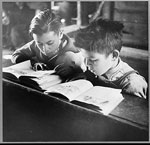Teaching the History of Teaching History
Question

I am looking for a book that explains the history of teaching historical thinking.
I teach historical thinking in a middle school and to home schoolers, and this topic always comes up, but I really don't know the answer.
Can you please provide some recommendations?
Answer
How intriguing that your students are interested in this. I’m afraid that books that explain this history are rare, if they exist at all. Generally, uncovering the history of teaching history and social studies is difficult. Sources that help us see into teachers’ classrooms and practices are few—sources that help us discern how historical thinking was addressed and integrated into classroom instruction narrow the possibilities even more. For an explanation of the difficulties in writing such a history, see Larry Cuban’s 1991 chapter, “History of Teaching in Social Studies,” where he discusses the “spotty” evidence and lack of available sources for studying classroom teaching in the past. However, Dr. Cuban makes the point that sources that illuminate changing ideas about what should be taught are more available than sources that document the changes that actually occurred in classrooms. We know that an American vision of history teaching as cultivating important habits of mind goes back to at least 1892 when the Committee of Ten, a group of mostly university and college professors who convened in an early effort to standardize education, recommended that the study of history should train judgment and prepare students to influence national affairs. Today, documents such as states’ content standards and the standards produced by the National Center for History in the Schools illustrate ongoing efforts to encourage and mandate the teaching of historical thinking in K-12 history courses. And during the intervening century, there were other efforts to encourage more teaching for historical thinking. Most notably, the New Social Studies Movement in the 1960s and 70s created a flurry of curricula that was designed to engage students in analyzing sources and investigating historical problems. Recommendations for teaching historical thinking (even if not explicitly called ‘historical thinking’) thread throughout the last century. While books documenting actual classroom practice are hard to find, books that address larger topics can have helpful excerpts. For example, see the second and third chapters of History on Trial: Culture Wars and the Teaching of the Past by Gary Nash, Charlotte Crabtree and Ross E. Dunn. These chapters include the history of the relationship between historians’ professional organizations and K-12 history education and some of the story of curricular debates regarding the teaching of historical thinking and analysis. Or try Peter Novick’s That Noble Dream: The “Objectivity Question” and the American Historical Profession for another look at these topics. Browse the book or use the index to find particulars about history in the schools. You will also find references to sources in both books that you can use to investigate further. But texts for middle schoolers that explain the history of historical thinking? I’m afraid they’re yet to be written!
Larry Cuban, “History of Teaching in Social Studies,” In Handbook of Research on Social Studies Teaching and Learning, ed. J.P. Shaver (New York: Macmillan Publishing Company, 1991). Gary Nash, Charolotte Crabtree, & Ross Dunn, History On Trial: Culture Wars and The Teaching of the Past (New York, NY: A.A. Knopf, 1997). Peter Novick, That Noble Dream: The "Objectivity Question" And The American Historical Profession (New York: Cambridge University Press, 1996).
